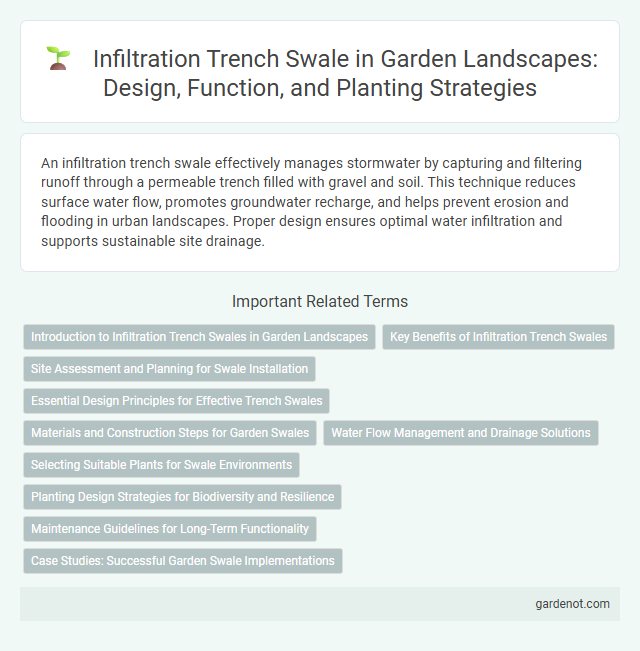An infiltration trench swale effectively manages stormwater by capturing and filtering runoff through a permeable trench filled with gravel and soil. This technique reduces surface water flow, promotes groundwater recharge, and helps prevent erosion and flooding in urban landscapes. Proper design ensures optimal water infiltration and supports sustainable site drainage.
Introduction to Infiltration Trench Swales in Garden Landscapes
Infiltration trench swales are designed to capture and filter stormwater runoff in garden landscapes, promoting groundwater recharge and reducing surface water pollution. These shallow, gravel-filled ditches are strategically placed to intercept rainwater, allowing it to slowly infiltrate the soil and minimize erosion. Incorporating native plants within infiltration trench swales further enhances water absorption and supports local biodiversity.
Key Benefits of Infiltration Trench Swales
Infiltration trench swales effectively manage stormwater by promoting groundwater recharge and reducing surface runoff, minimizing erosion risks. These structures enhance water quality by filtering pollutants and sediments before water infiltrates soil layers. Their ability to mitigate urban flooding and support sustainable drainage systems makes them essential in green infrastructure design.
Site Assessment and Planning for Swale Installation
Site assessment for infiltration trench swale installation involves evaluating soil permeability, topography, and groundwater levels to ensure effective stormwater management. Proper planning includes designing swales with appropriate dimensions and slopes to maximize infiltration while preventing erosion and overflow. Incorporating native vegetation enhances filtration capacity and supports ecosystem health within the swale system.
Essential Design Principles for Effective Trench Swales
Infiltration trench swales require carefully designed slopes between 1-5% to effectively manage runoff velocity and promote infiltration without causing erosion. Incorporating permeable materials such as gravel and sand in the trench base enhances water infiltration while facilitating sediment capture. Proper spacing and sizing based on local rainfall intensity and soil permeability are vital to ensure optimal hydraulic performance and prevent overflow.
Materials and Construction Steps for Garden Swales
Infiltration trench swales utilize permeable materials such as crushed stone, gravel, and coarse sand to promote efficient water absorption and reduce runoff. Construction begins with excavation to the desired trench depth, followed by the placement of a geotextile fabric liner to prevent soil infiltration while allowing water flow. Layers of aggregate materials are then meticulously installed, ensuring proper compaction and grading to maximize infiltration and support surrounding vegetation growth.
Water Flow Management and Drainage Solutions
Infiltration trench swales effectively manage water flow by capturing and slowly releasing stormwater, reducing surface runoff and promoting groundwater recharge. These drainage solutions minimize erosion and improve water quality through natural filtration processes. Properly designed infiltration trench swales enhance urban stormwater management, mitigating flood risks and supporting sustainable landscape practices.
Selecting Suitable Plants for Swale Environments
Selecting suitable plants for infiltration trench swales involves prioritizing species with deep root systems and high tolerance to fluctuating moisture levels. Native grasses, sedges, and wetland perennials like Carex and Juncus enhance soil permeability and prevent erosion in swale environments. These plants contribute to effective stormwater management by promoting infiltration and biofiltration within the trench swale system.
Planting Design Strategies for Biodiversity and Resilience
Infiltration trench swales incorporate diverse native plant species with deep root systems to enhance soil structure, increase water infiltration, and support local wildlife habitats. Strategic layering of herbaceous plants, shrubs, and grasses creates microhabitats, promoting biodiversity and ecological resilience in urban stormwater management. Selecting drought-tolerant and pollution-tolerant species ensures long-term functionality and adaptation to varying environmental conditions.
Maintenance Guidelines for Long-Term Functionality
Regular inspection and removal of sediment and debris from infiltration trench swales ensure optimal permeability and prevent clogging. Vegetation should be maintained by periodic mowing and removal of invasive species to promote healthy root systems that enhance infiltration. Proper maintenance schedules, including after heavy storms, help sustain hydraulic performance and extend the lifespan of the swale system.
Case Studies: Successful Garden Swale Implementations
Successful garden swale implementations demonstrate significant water infiltration improvements by using infiltration trench swales to effectively manage stormwater runoff. Case studies reveal that these systems reduce soil erosion, increase groundwater recharge, and support healthy vegetation growth in urban and suburban settings. Data from projects in California and Oregon highlight infiltration rates exceeding 200 mm/hr, showcasing their efficiency in sustainable landscape design.
Infiltration trench swale Infographic

 gardenot.com
gardenot.com